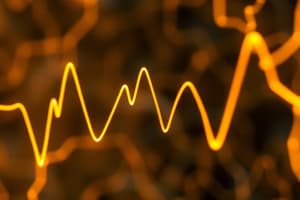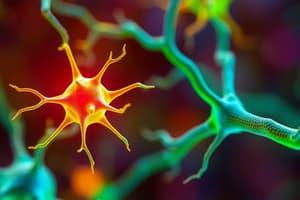Podcast
Questions and Answers
What does a threshold potential of -55mV indicate?
What does a threshold potential of -55mV indicate?
- The nerve's membrane is at rest
- Stimulus is too weak to open voltage-gated channels
- The nerve is fully depolarized
- A full action potential will occur (correct)
Which statement correctly describes the all-or-nothing principle?
Which statement correctly describes the all-or-nothing principle?
- Different nerves can have different action potential sizes
- All action potentials for a given nerve are the same size (correct)
- Action potentials only occur in response to subthreshold stimuli
- Action potentials vary in size depending on the strength of the stimulus
In neuronal activity, what occurs during the refractory period?
In neuronal activity, what occurs during the refractory period?
- The neuron cannot fire another action potential regardless of stimulus strength
- The neuron can easily fire another action potential
- The neuron is hyperpolarized and can only respond to strong stimuli (correct)
- The neuron is fully depolarized
How do local potentials differ from action potentials?
How do local potentials differ from action potentials?
What is the result when a stimulus exceeds the threshold potential?
What is the result when a stimulus exceeds the threshold potential?
If two stimuli both exceed the threshold, what happens according to the all-or-nothing law?
If two stimuli both exceed the threshold, what happens according to the all-or-nothing law?
What occurs if a stimulus is below the threshold?
What occurs if a stimulus is below the threshold?
What happens when sodium ions (Na+) enter a neuron?
What happens when sodium ions (Na+) enter a neuron?
What is the main event that occurs during depolarization of an action potential?
What is the main event that occurs during depolarization of an action potential?
Which phase of an action potential is characterized by the return of the membrane potential to resting levels?
Which phase of an action potential is characterized by the return of the membrane potential to resting levels?
What is the threshold for initiating an action potential as indicated in the content?
What is the threshold for initiating an action potential as indicated in the content?
Which ion channel is primarily responsible for repolarization in an action potential?
Which ion channel is primarily responsible for repolarization in an action potential?
What describes the phenomenon when an action potential overshoots the resting membrane potential?
What describes the phenomenon when an action potential overshoots the resting membrane potential?
What phenomenon explains why changes in membrane potential decrease as you measure further from the stimulation electrode?
What phenomenon explains why changes in membrane potential decrease as you measure further from the stimulation electrode?
What mechanism indicates that local potentials can trigger action potentials?
What mechanism indicates that local potentials can trigger action potentials?
During which phase of an action potential do voltage-gated Na+ channels primarily operate?
During which phase of an action potential do voltage-gated Na+ channels primarily operate?
What is the process called that describes the change from a negative to positive membrane potential?
What is the process called that describes the change from a negative to positive membrane potential?
Which area of the neuron is primarily responsible for integrating signals and generating action potentials?
Which area of the neuron is primarily responsible for integrating signals and generating action potentials?
Flashcards
Action Potential (AP)
Action Potential (AP)
A rapid, short-lasting change in membrane potential that travels along the axon of a neuron, transmitting signals from one neuron to another.
Passive Properties
Passive Properties
The electrical properties of a neuron that result from the flow of ions through the membrane, without any active involvement of ion channels.
Active Properties
Active Properties
The electrical properties of a neuron that are influenced by the opening and closing of ion channels, which control the movement of ions across the membrane.
Depolarization
Depolarization
Signup and view all the flashcards
Repolarization
Repolarization
Signup and view all the flashcards
Hyperpolarization
Hyperpolarization
Signup and view all the flashcards
Threshold
Threshold
Signup and view all the flashcards
Voltage-gated Na+ Channels
Voltage-gated Na+ Channels
Signup and view all the flashcards
Voltage-gated K+ Channels
Voltage-gated K+ Channels
Signup and view all the flashcards
Trigger Zone
Trigger Zone
Signup and view all the flashcards
What is the threshold potential?
What is the threshold potential?
Signup and view all the flashcards
What does 'all-or-nothing' mean in relation to action potentials?
What does 'all-or-nothing' mean in relation to action potentials?
Signup and view all the flashcards
How do we code for different stimuli if action potentials are all-or-nothing?
How do we code for different stimuli if action potentials are all-or-nothing?
Signup and view all the flashcards
What is the purpose of regeneration in action potentials?
What is the purpose of regeneration in action potentials?
Signup and view all the flashcards
How does membrane potential change during an action potential?
How does membrane potential change during an action potential?
Signup and view all the flashcards
What is the refractory period in action potentials?
What is the refractory period in action potentials?
Signup and view all the flashcards
What is the difference between local potentials and action potentials?
What is the difference between local potentials and action potentials?
Signup and view all the flashcards
What is the role of Na+ entry in action potentials?
What is the role of Na+ entry in action potentials?
Signup and view all the flashcards
Study Notes
Course Information
- Course: MD137
- Course title: Introduction to Physiology
- Lecturer: Leo Quinlan
- Lecturer email: [email protected]
- Academic year: 2024-2025
Lecture 3: Action Potentials
- Topic: Action potentials (AP)
- Subtopic: Neural Signaling
- Learning Outcomes:
- Define action potential
- Detail the main ion movements during AP formation
- Explain the role of ion channels and the concept of threshold
- Describe the kinetics of an AP
- Students are encouraged to think positively about action potentials
### Polarization States of the Membrane
- Action potentials are represented by changes in membrane potential difference (Vm).
- Depolarization occurs when the membrane potential becomes less negative.
- Repolarization occurs when the membrane potential returns to its resting state.
- Hyperpolarization occurs when the membrane potential becomes more negative than the resting potential.
- The voltage, measured in milivolts (mV), changes during these phases.
Passive Properties
- Henry and Huxley discovered that the membrane potential responds to stimulation, but its response decreases as the electrode is moved further from the stimulation site.
- These properties characterize passive signal transmission in a neuron.
Active Properties
- A small depolarizing stimulus (e.g., -65mV) produces a local potential change.
- Stimulus recordings are measured at different locations (e.g.,REC 1, REC 2, REC 3).
- Increasing the depolarizing stimulus (e.g., -60mV, -55mV, -40mV) causes action potentials to emerge at different recording locations.
- As the stimulus is increased, propagation of the stimulus leads to an increasing frequency of action potentials.
- Local potentials are graded potentials.
Generating Action Potentials
- The threshold potential is -55 mV
- Stimulus initiating the action potential at the trigger zone.
- Action potentials are characterized by depolarization, repolarization, and recovery (resting state with refractory period).
Phases of Action Potentials (AP)
- Depolarization: Voltage-gated Na+ channels open, Na+ ions enter the cell.
- Repolarization: Voltage-gated Na+ channels close, and K+ channels open, K+ ions leave the cell.
- Hyperpolarization: K+ channels stay open for a brief period, leading to membrane potential becoming more negative than resting potential.
Ion Channel Inaction During APs
- Voltage-gated Na+ and K+ channels are crucial for action potential generation.
- Na+ channels open rapidly, leading to depolarization.
- Na+ channels inactivate, stopping further Na+ influx.
- K+ channels open, leading to repolarization and hyperpolarization.
All-or-Nothing Principle
- The amplitude of action potentials is consistent for a given neuron.
- Action potentials are "all-or-none," meaning that either an action potential is initiated or it isn't, with no in-between values.
Regeneration of Action Potentials
- Action potentials regenerate along the length of the axon.
- The signal does not diminish as it propagates down the axon.
Membrane Potential Reversal During Action Potentials
- During depolarization, the inside of the axon becomes positive relative to the outside.
- Reversal in the membrane potential occurs due to ion movement across the membrane.
Refractory Period
- Absolute refractory period: The neuron cannot generate another action potential because sodium channels are inactivated.
- Relative refractory period: The neuron can generate another action potential, but a larger-than-normal stimulus is needed.
Different Action Potential Times
- The duration of an action potential varies depending on the type of neuron (e.g., cardiac muscle, skeletal, motoneuron).
Local/Graded Potentials Vs Action Potentials
- Local/Graded potentials:
- Vary in size and shape according to the stimulus.
- Decrease as they move away from the stimulus site.
- Action potentials:
- Uniform in size, shape.
- Regenerated along the axon, without decreasing in size or magnitude.
Learning Outcomes (Recap)
- Students should understand action potential characteristics.
- Definition
- Ion movements
- Role of ion channels
- Kinetics
Studying That Suits You
Use AI to generate personalized quizzes and flashcards to suit your learning preferences.




